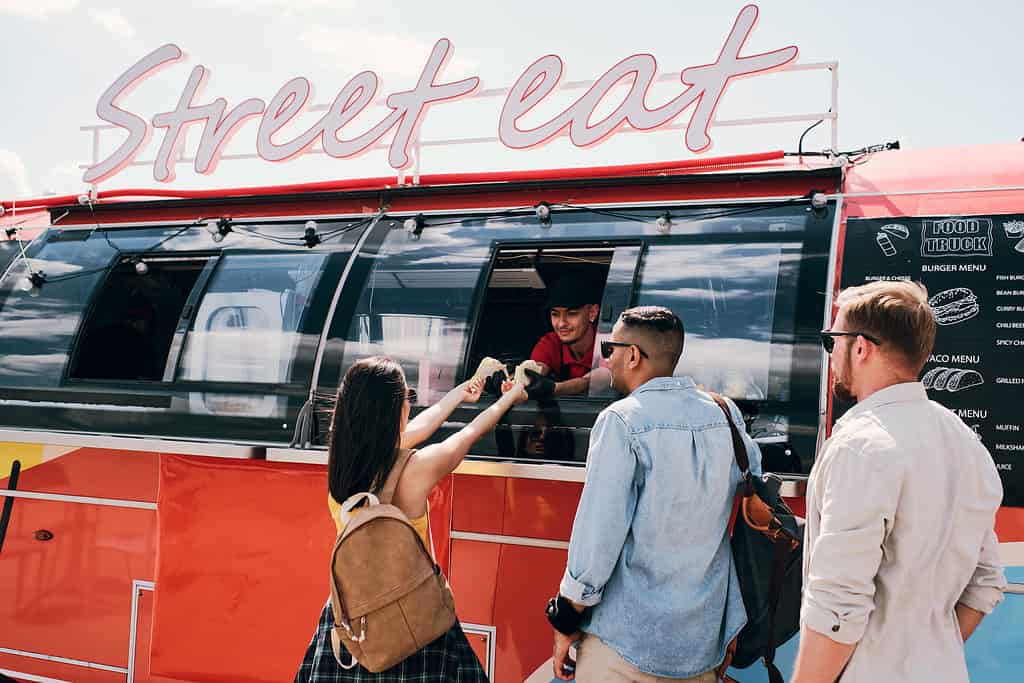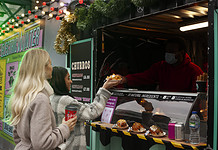Launching a successful business requires a well-thought-out plan that steers your venture to success. And like any other business, your food truck business needs a plan. So, how do you get started? What are the operational costs and potential risks? What are your goals?
Answer such questions and more before launching your food truck business. Thankfully, your business plan will help answer all. This article looks into why you should plan for your truck business and what to include in your food truck business plan.

What Does a Food Truck Business Plan Need?
A business plan is a written document that guides investors, owners, or managers on how to start and operate a business. It’s a practical guide that allows you to translate your idea or passion into a lucrative venture.
When starting a food truck business, a business plan helps you know what you’ll do at every growth stage. You’ll know what to do and expect, including the food to sell, marketing, financing, risks, and growth plans. If you’re looking to pitch investors, your food truck business plan helps convince them that you have a lucrative business venture.
Why Do You Need a Plan for Your Food Truck Business?
Your food truck business plan is a critical document that serves as a reference point when running the business. Since you’re investing a lot of money, it makes sense to spend a little time planning how your business will operate. Below are the reasons for writing a business plan for your food truck venture.
Set and Organize Goals
As with any other business, you need to set goals for your food truck business. Think about how much you want to make in a day to where you want to be in five years. Remember to include all your short-term and long-term goals. After setting goals, organize them in a way that makes achieving them possible.
Helps You With Financing
If you’ve not saved enough to start your food truck business, you need to consider where you’ll access funds. Will you approach investors or a bank to offer you a business loan? How much do you need to kick-start the food-truck venture?
Helps You Research the Market
If you’ve not considered your product line, target market, and competitors, your business plan can come in handy. You’ll be able to research the market to identify a gap. After finding a gap, you’ll know who your target customers are and where to find them. Lastly, you’ll spot competitors and plan how you’ll outmaneuver them.
Serves as a Reference Point
As your food truck business grows, you’ll need a reminder of your goals and what you should do at each growth stage. In the case of challenges, the business plan helps you know how to navigate them.
What To Include in a Food Truck Business Plan
A traditional business plan can be a good starting point. However, a food truck business plan has a few differences.
Here are the elements of your food truck business plan.
Executive Summary
An executive summary is a general review of what’s included in your business plan. This section introduces what your business deals with, the target market, locations and business operations, goals, and a budget overview.
Since you include the most critical elements in your business plan, you should write this section last. Ensure anyone who reads the executive summary understands what your business entails.
After reading the executive summary, anyone should understand why it’s a lucrative business.
Company Overview
The company overview section of your food truck business plan describes your business in detail. Here, you explain what you highlighted about your business in the executive overview. Provide a company description to help one understand the type of food truck business you’re operating.
Besides describing the type of business, try to answer questions such as why start a food truck business? What makes your food truck business stand out? Who do you target to serve? Where will your food be prepared?
Market Analysis
Market analysis involves researching the food industry to understand the market you’re about to join. Your assessment should begin with the market trends.
If customers around your operation areas prefer specific menus, your research should help identify them. Consider how big the market is and if it has signs of increasing or decreasing.
Identify key demographic information about your target market, such as age group, gender, economic status, and location. Consider their needs and seasonal trends.
If there’s a demand for the food you’re offering, you’ll face competition. Identify both direct and indirect competitors. Mention your competitors’ strengths and weaknesses. By analyzing your competition, you can include what you’ll do to beat the competition.
Location and Business Operation
Unlike restaurants, your food truck business is mobile. It’s up to you to identify and go where your target customers are. Remember, your customers will want to know where you’ll be every day, at given hours.
Write down a schedule, highlighting specific locations you’ll go to each day and at what time. The areas you plan to park and sell should allow you to access your target customers.
After planning your locations, it’s time to consider your operations plan. Be sure to include all the tasks to be carried out each day. Include information about accounting, customer service, sales, and where to find the supply of your products. If you have any anticipated challenges, consider how to overcome them.
Team and Management Plan
This section of your food truck business plan should describe your team and each member’s role. Whether you’re a food truck business of two or more workers, it’s important to highlight what everyone should do.
Start with the management and state who’s in charge and their roles. Include the number of team members, their skills and experiences in the food industry, salaries, and growth opportunities.
Highlight the type of partnership, each partner’s percentage, expected benefits, and what happens if one partner quits. Consider how you’ll hire workers and whether you’re hiring them full-time or part-time.
Menu
A menu is an integral part of your food truck business. Create a sample menu highlighting the food you intend to offer. Ensure your menu is detailed and unique. For your business to retain and attract more customers, you must be creative in your offer. Allow your creative juices to flow when considering unique flavors and how your food will entice more customers.
Pricing is another aspect to consider when creating a menu. Consider the costs of preparing your food and how much the food will cost. Besides creating a menu, provide detail of all ingredients needed and their shelf life.
Branding and Marketing Strategy
Branding and marketing are vital in creating awareness about your business. The food truck industry is booming, and you must market your brand to attract customers. The first thing you’ll want to consider is branding your business.
Look at the food trucks around and adopt a similar design. You can also use a billboard and make the exterior of your food truck appealing. This will help customers to recognize your food truck business fast.
Apart from attracting passersby, you need to market your business to potential customers in their workplaces, colleges, and places of residence. You can use promotional methods such as:
- Media advertisement
- Social media advertisement
- Free samples
- Flyers
- Customer loyalty program
Financial Plan
The success of your food truck business hinges on how practical and realistic your financial plan is. This section covers financial projections, funding, and how you’ll allocate funds. If you’re pitching investors, they’ll want to go through this section to understand whether your business is viable or not.
Funding, money allocation, and expenses should help create a financial projection. Consider the price of your food truck, food insurance, permits, cost of food and equipment, labor costs, fuel, and other expenses. Use the projected sales and expense budget to calculate the expected profit.
Adjust where necessary to ensure your business looks profitable. With a complete financial plan, you can determine the amount of startup capital needed. You can use savings to fund your business or approach investors/banks for funding. Your investors or banks will want to know how you plan to repay the loan.
Appendix
The appendix is the final part of your food truck business plan. Do you have any crucial information that you can add to your business plan but can’t fit in any of the above sections? The appendix is where to include it.
You can include pictures, building permits, reference letters, financial statements, licensing documents, and design blueprints.
Final Thoughts
A business plan can help you overcome many challenges when launching and operating your business. If you’re looking forward to a profitable business, your business plan will guide you on every step.
Include the above elements in your food truck business plan to help you launch a successful business. The business plan will allow you to understand your goals, market, competitors, responsibilities, and how you’ll finance your venture.



















